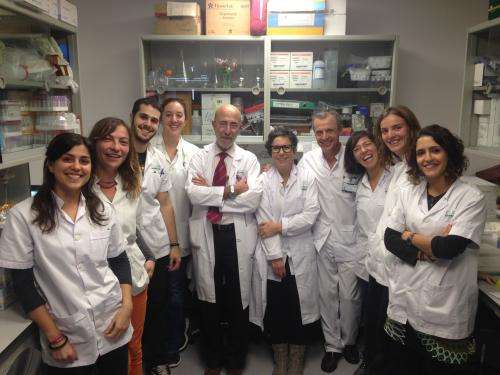A large amount of mitochondrial toxic agents cross the placenta barrier

Researchers from the Hospital Clinic of Barcelona (Spain) have reviewed ten years' worth of scientific studies on mitochondrial toxicity in pregnant women. Exposure to toxic agents such as viruses, certain drugs, pesticides, alcohol and tobacco cause mitochondrial diseases about which very little is known, and which are transmitted from the mother to the foetus.
Mitochondria, the cellular 'powerhouses' in charge of producing energy in the different organs of the body, can suffer from two types of disease: genetic or acquired. Only the first type has just found some kind of relief in new legislation in the United Kingdom. There, the DNA of three people can be used in assisted reproduction to avoid the transfer of genetic mitochondrial diseases from the mother to the foetus.
However, the mitochondria can also suffer acquired pathologies due to, for example, exposure to toxic agents transferred from mother to child, causing conditions such as muscle weakness, inflammation of the pancreas and changes in the distribution and amount of body fat.
A team from the Muscle Research and Mitochondrial Function Laboratory at the Hospital Clinic of Barcelona has reviewed the little information there is available on mitochondrial toxicity in pregnant women over the last ten years. Their report, published in the International Journal of Environmental Research and Public Health, reviews more than 100 studies from the Pubmed/MEDLINE database.
In the report, the researchers propose alternatives in order to avoid any harmful effects for pregnant women and their babies based on two strategies: the search for toxicity markers and the avoidance of any contact with mitochondrial toxic agents.
"There are many agents which encourage this kind of toxicity. These include biological agents such as certain viruses, antibiotics, antiretroviral drugs, antipsychotic drugs, gases such as carbon monoxide and chemical substances such as pesticides, alcohol and tobacco, to name but a few", as Constanza Morén, lead author of the study, explains to SINC.
"Perhaps alcohol and tobacco are the most common agents, whose exposure we can avoid through awareness. Yet many others are drugs, and therefore, it is fundamental to get across the hugely harmful capacity that these have to the clinical community", says Morén.
The length of the exposure, dose of each toxic agent and stage of the pregnancy in which it is received all make toxicity in pregnant women more probable. There is also a genetic predisposition that can determine whether a person is more resistant or vulnerable to that exposure.
"In the mitochondrial world, there are the so-called haplogroups, which determine the genetic makeup of our mitochondria. The haplogroup you belong to can condition your resistance to mitochondrial alterations", Morén comments.
With regard to the total number of pregnant women who suffer from mitochondrial toxicity, Morén insists that "it is extremely complicated to give an exact figure; we can only assume that there are at-risk populations. For example, in developed countries, it is estimated that between 10% and 25% of pregnant women smoke, who would be an at-risk group in suffering this type of toxicity, but it does not mean that they all develop it".
A surmountable barrier
The transfer of mitochondrial toxicity from mother to child can occur at conception (parents' reproductive cells may have been affected) until the end of breastfeeding.
Sometimes, the toxicity is transferred from the mother to the foetus because the placenta does not act as a barrier against all substances. The toxic agents have the ability to travel through the mother's bloodstream and reach the foetus during its development by crossing over any protection filter.
An example is that of antiretroviral medication administered to pregnant women who are HIV positive, although these drugs have more benefits than would stopping the treatment to avoid toxicity. "This is a case of unavoidable mitochondrial toxic agent exposure during pregnancy", Morén explains.
Unknown effects
The consequences for the mother and foetus can range from being asymptomatic (without evident clinical manifestations) in the majority of cases, to fatal on rare occasions. Sometimes the toxicity is the reason behind obstetrical problems for the pregnant women: premature labour, intrauterine growth restriction and pre-eclampsia.
"As the mitochondria participate in vital processes for cell viability and in addition, mitochondria are present in almost all tissues and cell types, if visible clinical manifestations appear they can be observed in almost any organ or tissue", states Morén.
Some examples of visible effects are the redistribution of the organism's body fat (lipodystrophy), pancreatitis, encephalitis, myopathies or hyperlactatemia and lactic acidosis, among others.
Searching for biomarkers
According to the researchers, the best way to prevent mitochondrial toxicity is to avoid exposure to the agent during pregnancy. "In cases where this is not possible, the possibility of reducing the exposure as much as possible should be examined and clinical practice should include the use of mitochondrial toxicity markers", says Morén.
"Given that prevention is not always possible against accidental or therapeutic exposure, it is essential to identify less toxic substances for the mitochondria, as well as biomarkers (preferably non-invasive) which can give us a clue to its development and facilitate the monitoring of this toxicity during pregnancy", she warns.
The researchers are currently examining the possible underlying mitochondrial basis in intrauterine growth restriction. They have also completed a study on mitochondrial toxicity and apoptosis in pregnant women who are HIV positive for their publication in the scientific journal AIDS .
Morén also works on establishing in vitro models to study the underlying molecular mechanisms and search for biomarkers for this type of toxicity. She also analyses the genetic mitochondrial changes caused by the exposure of pregnant women to HIV and antiretroviral drugs in collaboration with Vall d'Hebron and Sant Joan de Déu hospitals.
More information: Morén, C., Hernández, S.,Guitart-Mampel, M., Garrabou, G. "Mitochondrial Toxicity in Human Pregnancy: An Update on Clinical and Experimental Approaches in the Last 10 Years". International Journal of Experimental Research and Public Health, 2014. DOI: 10.3390/ijerph110909897

















